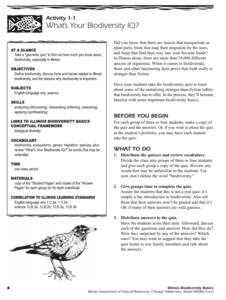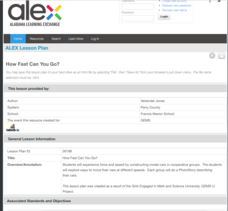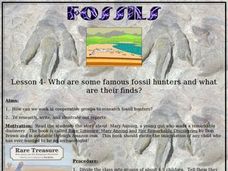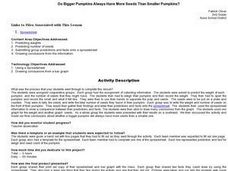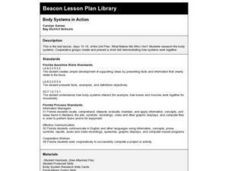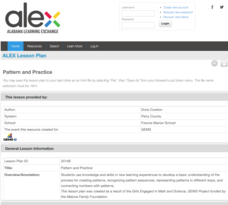Curated OER
Digital Scavenger Hunt
Students participate in a game of scavenger hunt. In this teamwork lesson, students use clues to find hidden objects. Students must work cooperatively to complete each task.
Curated OER
Life Cycles
Using computers, Students work in small groups and progress through the roles of Explorer, Researcher, Designer, and Evaluator as they study the life cycle of plants, insects, butterflies and frogs.
Curated OER
Planets And Moons Web Quest
Students work with a partner using the Internet to find the answers to a web quest about space exploration. They work in cooperative groups to discuss information and evaluate its importance to space exploration.
Curated OER
Famous Comets
Pupils research comets. In this astronomy lesson, students work in cooperative groups to research notable comets. They write a creative narrative report and present their findings to the class.
Safe Drinking Water Foundation
To Filter or Not to Filter
Drinking clean water can be taken for granted. Explore the process and high cost of filtering water with a water pollution and filtration activity. Young scientist build a filtration system to filter polluted water, examine the economics...
Illinois Department of Natural Resources
Section One: What is Biodiversity?
Four intriguing and scientific activities invite learners to explore the natural resources of their town. The activities cover concepts such as genetic traits, organizing species in a taxonomy, the differences between different species...
Science Matters
Oh Heron
Two teams—the environmentalists and herons—play four rounds of the game, Oh Heron. Using hand symbols to represent food, shelter, and water, players locate their match to produce more herons while those unmatched decompose.
Curated OER
Geology: Famous Rock Groups
Fourth graders, in groups, use books to identify types of rocks. They examine the rocks and complete rock evidence charts. Students compose definitions for each rock type and determine uses for igneous rocks by early mankind.
Curated OER
Find the Frog
Students, the advanced beginner to intermediate ESL level, use English in a science activity.
Alabama Learning Exchange
How Fast Can You Go?
Learners investigate force and speed. In this physics instructional activity, students construct model cars in small groups and perform experiments to identify what factors influence speed and force.
Curated OER
Our Own Water Music
Students listen to a portion of Handel's Water Music Suite and hypothesize about what would happen if you tapped on the edge of a glass with varying levels of water. They experiment with the glasses and, in small groups, compose their...
Alabama Learning Exchange
The Mean, Median, and Mode Chain Gang
Learners analyze a set of data. They work in cooperative groups and use chain links to identify the mean, median, and mode of the chain.
Curated OER
Stem Cell Research Policy Lesson Plan: Create an Advocacy Brochure
Students after researching the science and the controversy around stem cell research, students create brochures to display their knowledge and a point of view.
Curated OER
So You Want To Travel To Namib
Students research and plan a trip to the Namibian desert. They watch and discuss a video, develop a list of the harsh conditions while viewing the film, identify the precautions needed for traveling in the Namib environment, and write...
Curated OER
The Cay: Creatures of the Coral Reef
Students make a connection between science and literature. After reading the first five chapters of the novel The Cay, they describe the physical characteristics of a coral reef, as well as describe and distinguish between the many...
Curated OER
Density
Students determine the density of different substances. In this physical science lesson, students rank them according to their density. They discover the relationship between volume and density.
Curated OER
Where Are the Dinosaurs?
Students investigate dinosaurs. In this life science instructional activity, students watch video clips on the website http://dsc.discovery.com/convergence/dinos/video/video.html and discuss the characteristics of the dinosaurs. Students...
Curated OER
Astronaut's Favorite Foods
Students examine space food. For this space science lesson, students visit suggested websites to identify the eight categories of space food. Students use a space food nutrition guide to classify space food.
Curated OER
Fossils Lesson 4 - Who Are Some Famous Fossil Hunters and What Are Their Finds?
Learners research and develop a presentation about a famous fossil hunter/archaeologist. In this fossil hunter/archaeologist instructional activity, students listen to a reading of Don Brown's, Rare Treasure: Mary Anning and Her...
Curated OER
Do Bigger Pumpkins Always Have More Seeds Than Smaller Pumpkins?
Second graders, in groups, predict the weight of a pumpkin and the number of seeds it might have. Then they find and record the actual weight and actual number of seeds. They compare and contrast the size of the pumpkin to the number of...
Alabama Learning Exchange
Mr. Crocodile's Busy Day
Demonstrate how to read analog and digital clocks to the hour in this time measurement lesson. Read the book What Time is it Mr. Crocodile? and use Mr. Crocodile's schedule to practice telling time. They work in cooperative groups to...
Curated OER
Body Systems in Action
Fifth graders, in groups, create a short skit that shows how body systems work together.
Curated OER
Landforms
Students study how landforms affect all aspects of a community. Students work in groups to identify landforms from other works of art. In cooperative groups Students select a work of art depicting a particular land form and create a poem.
Alabama Learning Exchange
Pattern and Practice
Young scholars learn how to make patterns. Students first display their prior knowledge of patterns before delving into the lesson. They complete a worksheet and participate in a web-based class activity. They work in cooperative groups...





